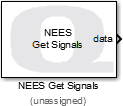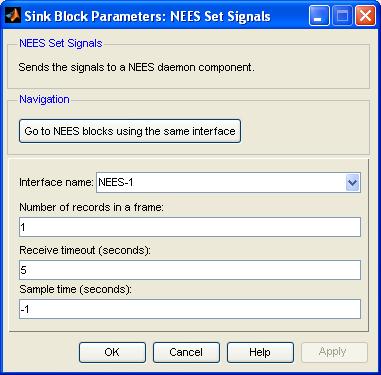

NEES Set Signals
| The NEES Set Signals block has been deprecated and should not be used in new models. |
This block sends data to a NEES daemon.
Library
QUARC Targets Deprecated/Communications/NEES MATLAB Command Line Click to copy the following command line to the clipboard. Then paste it in the MATLAB Command Window: qc_open_library('quarc_library_deprecated/Communications/NEES')
Description

This block streams the data at its input to the Quanser NEES Daemon. The daemon then forwards the data from all NEES Set Signals to the selected RBNB Data Turbine repository. The name of the data in the repository is the full hierarchical path to the NEES Set Signals in the Simulink diagram. For efficiency, the data is streamed to the Java daemon in frames. Each frame consists of a number of records, where each record contains the value(s) of the input(s) to the NEES Set Signals at a single sampling instant.
For example, if the input to the NEES Set Signals is a 3-vector, then a record contains 3 elements. If the sampling rate of the system is one kiloHertz and the number of records in a frame is set to 100, then the NEES Set Signals will send 100 records (300 elements) to the Java daemon (and on to RBNB) every 10th of the second.
Installation Requirements
Java Version
 The Quanser NEES Daemon requires that Java 8 (also known as 1.8) or above be installed.
A suitable Java Runtime Environment may be found online at https://www.oracle.com/java/technologies/downloads/.
Refer to the Quanser NEES Daemon help page for more details.
The Quanser NEES Daemon requires that Java 8 (also known as 1.8) or above be installed.
A suitable Java Runtime Environment may be found online at https://www.oracle.com/java/technologies/downloads/.
Refer to the Quanser NEES Daemon help page for more details.
Input Ports
data
The data to send to the NEES daemon. This data can be in n-vector format which means sending n signals at the same time to the same daemon.
Output Ports
This block has no output ports.
Parameters and Dialog Box

Go to NEES blocks using the same interface
Opens a dialog that lists all the NEES blocks in the model which are currently using the same interface selected in the Interface name parameter. The dialog may be used to go to another NEES block in the model just by double-clicking on the name of the block in the dialog box.
Interface name
The name of the interface containing the component whose value will be retrieved. Interfaces are configured using the NEES Initialize block. Place a NEES Initialize block in your diagram to add an interface name to the list.
Number of records in a frame
The number of records (sampling instants) in a frame. This parameter defines how often the block will send the data to the Quanser NEES Daemon, and on to the RBNB repository.
Receive timeout
The amount of time in seconds that the block will wait to receive data in a given sampling instant. Specify a value of 0 for no timeout. A non-zero timeout prevents the real-time code from being delayed by the non-real-time operation of the repository.
Sample time
The sample time of the block. A sample time of 0 indicates that the block will be treated as a continuous time block. A positive sample time indicates that the block is a discrete time block with the given sample time.
A sample time of -1 indicates that the block inherits its sample time. Since this is a source block, only inherent the sample time when it is placed in a conditionally executed subsystem, like a Triggered or Enabled Subsystem, or in a referenced model.
To use the fundamental sampling time of the model, set the sample time to qc_get_step_size, which is a QUARC function that returns the fundamental sampling time of the model.
Targets
|
Target Name |
Compatible* |
Model Referencing |
Comments |
|---|---|---|---|
|
Yes |
Yes |
Only supported in normal simulation. |
|
|
Yes |
Yes |
Only supported in normal simulation. |
|
|
Yes |
Yes |
||
|
Yes |
Yes |
||
|
Yes |
Yes |
||
|
Yes |
Yes |
||
|
Yes |
Yes |
||
|
Yes |
Yes |
||
|
Yes |
Yes |
||
|
Yes |
Yes |
||
|
No |
No |
Not supported. |
|
|
Yes |
Yes |
||
|
No |
No |
Not supported. |
|
|
No |
No |
Not supported. |
|
|
Rapid Simulation (RSIM) Target |
No |
No |
Not supported. |
|
S-Function Target |
No |
N/A |
Old technology. Use model referencing instead. |
|
Normal simulation |
Yes |
Yes |
Fully supported. Use System Timebase block in Normal simulation. |
See Also

Copyright ©2025 Quanser Inc. This page was generated 2025-11-01. Submit feedback to Quanser about this page.
Link to this page.